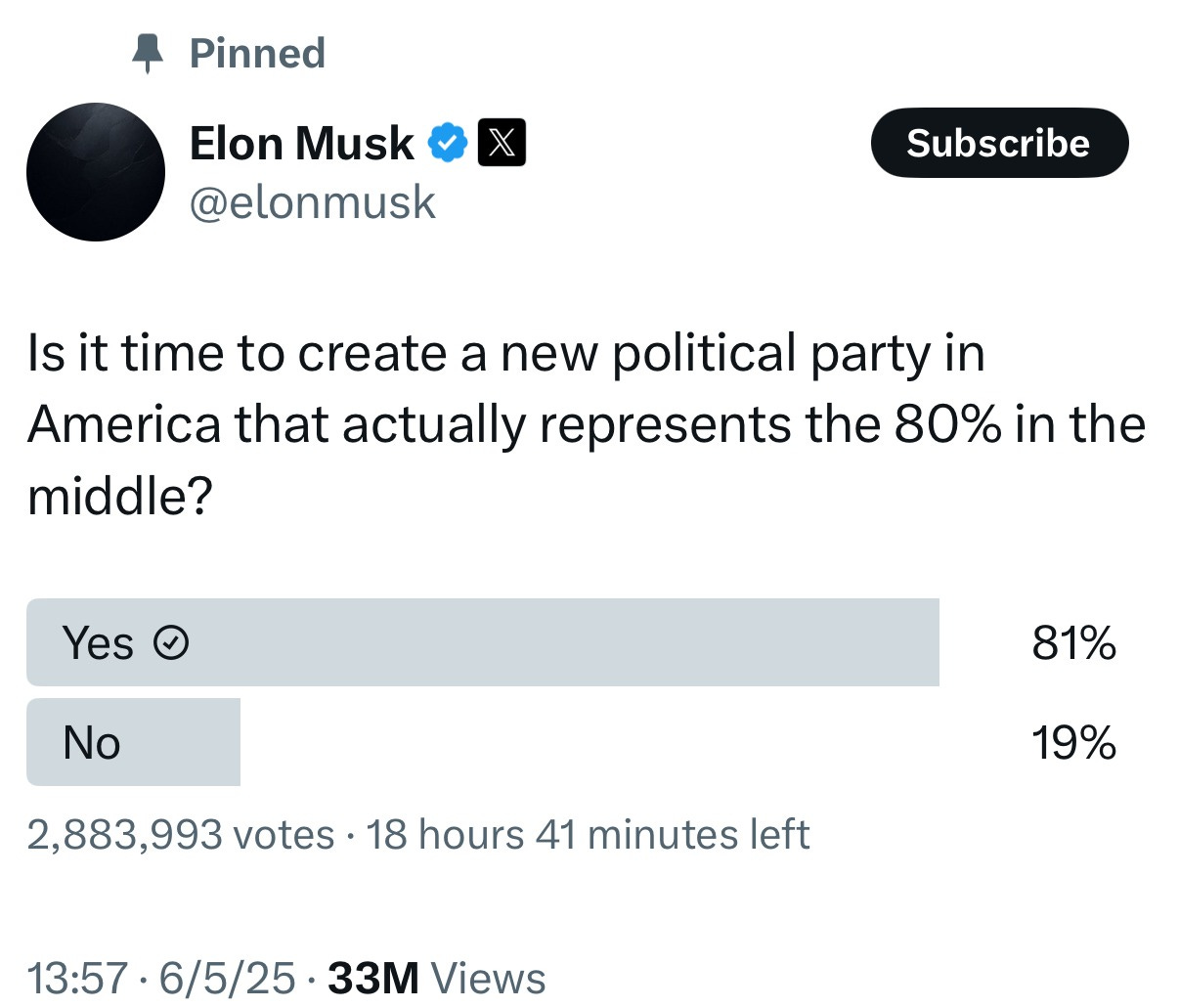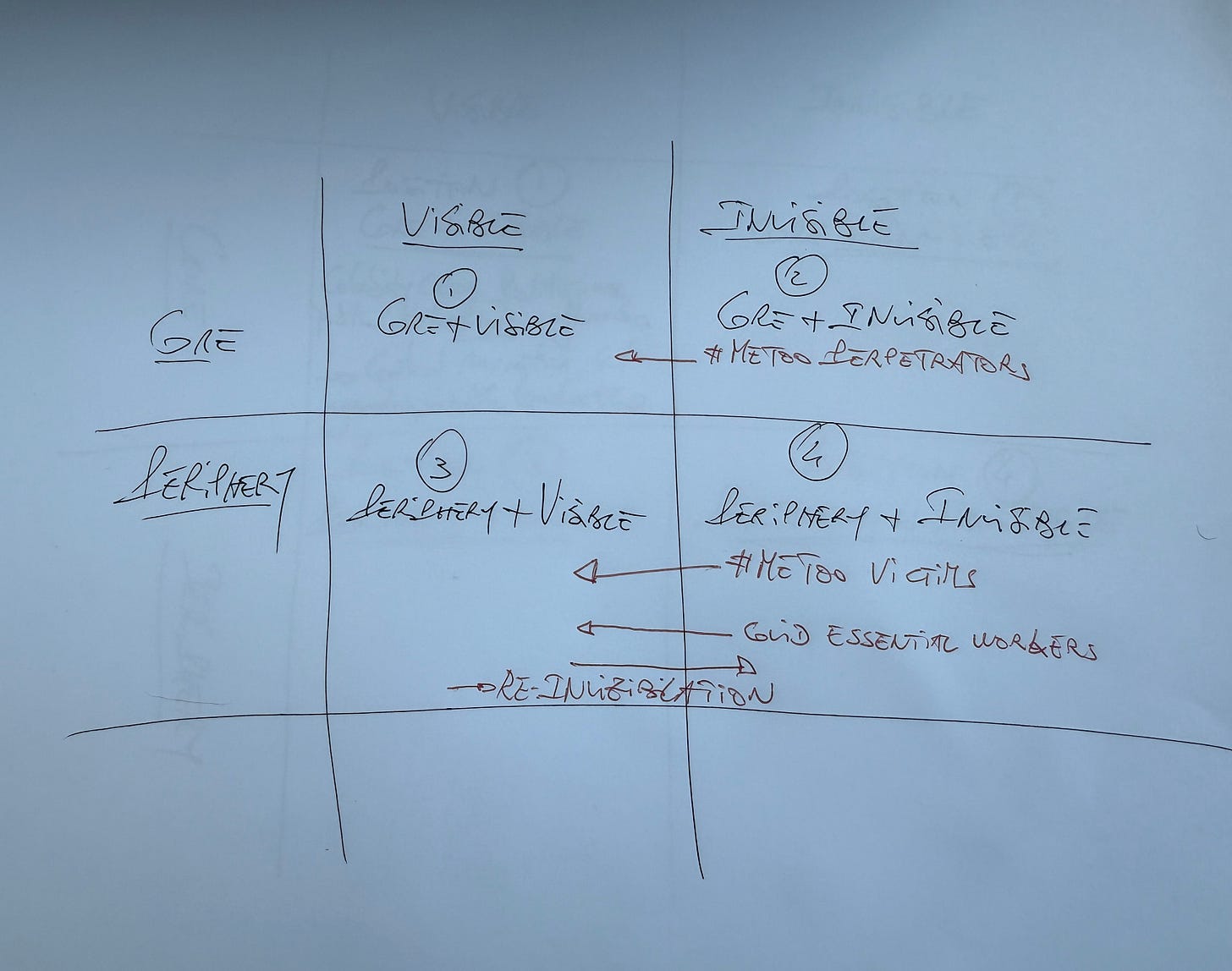Beyond Left and Right: How Visibility and Power Shape the New Political Landscape
The collapse of traditional political categories reveals a deeper struggle over who gets seen, who gets heard, and who controls the narrative.
The Death of Left vs. Right
I got really interested by two pieces of information this week. First, today, a Musk tweet about the need - or not - for a new party that would “represent the 80% in the middle”
Secondly, a captivating episode of The Daily last Tuesday, showing that something fundamental has broken in American politics, and the numbers are stark. Over the last four presidential elections, more than 1,400 counties—nearly half of all counties in America—have moved continuously toward Republicans. Meanwhile… only 57 counties have trended Democratic.
But here's what makes this shift revolutionary rather than just cyclical: it's not happening along traditional left-right lines. The counties moving Republican aren't just rural and white. They include diverse urban neighborhoods in the Bronx, Latino border communities in Texas, and Black neighborhoods across major cities. Meanwhile, Democrats are consolidating in wealthy, highly educated enclaves like Los Alamos, New Mexico—home to the national laboratory where nuclear physicists live.
This isn't just about conservative versus liberal ideology anymore. It's about something deeper: a fundamental reorganization of politics around who has options versus who doesn't, and crucially, who gets seen and heard in our political system versus who remains invisible.
The Global Pattern: From Yellow Vests to Trump
This phenomenon isn't uniquely American. In 2018, France erupted with the Yellow Vests movement—protesters from rural and suburban areas who felt abandoned by Parisian elites. What started as resistance to fuel tax increases quickly became something larger: a rebellion by people who felt invisible to power.
The Yellow Vests were (mostly) workers and families who had no choice but to drive long distances for work, yet were ignored in policy discussions dominated by urban environmentalists who could take public transit. They were physically present, economically necessary, but politically invisible—until they forced themselves into visibility through sustained protest.
The pattern repeats globally: from Brexit voters in post-industrial English towns to populist movements across Europe and 2019 mass protests in Chile. Traditional left-right politics fails to explain why working-class voters of all ethnicities are abandoning center-left parties that claim to represent them, while educated professionals retreat into increasingly narrow geographic and cultural enclaves.
The Concentric Circles of Global Power
At the global scale, this dynamic operates through concentric circles that mirror domestic patterns. The Global North—Europe, North America, parts of Asia—functions as the "core," concentrating wealth, technology, and decision-making power. The Global South often occupies the "periphery," providing resources, labor, and markets while having little influence over the rules of the global system.
But visibility operates differently across these circles. Climate conferences showcase Western environmentalists while rendering invisible the Congolese children mining cobalt for electric car batteries. Tech platforms celebrate innovation in Silicon Valley while hiding the Kenyan content moderators who screen disturbing material for a fraction of Western wages. The Global North maintains a "frictionless" lifestyle precisely because the friction—the exploitation, pollution, and labor—remains invisible by design in the Global South.
This creates what economist Kohei Saito calls an "Imperial Mode of Living," where comfortable lifestyles in wealthy countries depend on making the true costs invisible to those who benefit.
When Being Seen Isn't Being Recognized
The distinction between different types of visibility becomes crucial here.
I was truly moved last year by "Going Dark," a recent exhibition at the Guggenheim Museum that explored what it means for people of color to be visible in America. As photographer John Edmonds put it: "You're continually being scrutinized and watched. But never really seen."
This captures a profound paradox: you can be hypervisible to surveillance systems while remaining invisible to recognition systems. Some Black Americans know this intimately—constantly watched by police, security cameras, and suspicious stares, yet their full humanity, achievements, and perspectives remain largely invisible in mainstream discourse. Part of their experience is what might be called "surveillance visibility" while being denied "recognition visibility."
The same dynamic shapes how different groups experience political attention. Essential workers during COVID were briefly visible as "heroes" but quickly re-invisibilized after. Undocumented immigrants are hypervisible to deportation enforcement but invisible in policy discussions about economic growth, despite their essential contributions.
This helps explain why traditional political categories feel inadequate. The question isn't just whether someone is on the left or right, but whether they have the power to be visible on their own terms versus being subjected to visibility imposed by others.
The Four Positions of Political Power
To understand our new political landscape, I suggest a new framework that captures both economic position and visibility dynamics. Think of politics as operating along two intersecting axes:
Vertical Axis: Core vs. Periphery
Core: Those with economic power, resources, and structural advantages
Periphery: Those economically marginalized, with limited resources and options
Horizontal Axis: Visible vs. Invisible
Visible: Those who can be seen, heard, and recognized in political discourse
Invisible: Those ignored, overlooked, or subjected only to surveillance
This creates four distinct political positions:
Position 1 (Core + Visible): The Seen Elite Celebrity CEOs, prominent politicians, public intellectuals, successful influencers. They control resources AND control the narrative. They're not just wealthy—they're visible on their own terms, setting agendas and shaping public discourse.
Position 2 (Core + Invisible): The Hidden Powers
Algorithm designers, financial system architects, private equity managers, tech platform controllers. They have enormous economic power but prefer to operate behind the scenes, shaping systems without scrutiny.
Position 3 (Periphery + Visible): The Recognized Resistance Social movements that gain public attention, prominent activists, protesters who successfully capture media attention. Also includes individuals who briefly gain visibility through tragedy or injustice - victims of police violence, publicized immigration cases, people thrust into the spotlight by circumstances beyond their control.
They lack economic power but have managed to become visible and influence discourse.
Position 4 (Periphery + Invisible): The Forgotten Majority Essential workers, rural communities with no alternatives, content moderators overseas, gig workers, undocumented immigrants, sex workers, elderly people in nursing homes, etc.
They perform necessary functions but remain invisible to policy discussions.
How Trump Exploited the Visibility Gap
Donald Trump's political talent was recognizing that millions of Americans occupied Position 4—economically peripheral and politically invisible—and offering them Position 3 visibility. His "forgotten Americans" rhetoric explicitly acknowledged people who felt unseen by the political system.
The 1,400 counties data shows this strategy's success. Trump didn't just win rural areas; he gained ground anywhere people felt they had "no other options" while being ignored by people with options.
Meanwhile, Democrats increasingly retreated to Position 1 areas—wealthy, educated enclaves where their voters were both economically comfortable and culturally visible. They became the party of people with options talking to other people with options, while those without alternatives felt increasingly invisible.
The Strategic Battle Over Recognition
This framework reveals why traditional political strategies are failing. Democrats focused on highly specific policy proposals (student loan forgiveness, green energy subsidies) that primarily benefited people who already had options, while making grand symbolic gestures around identity and representation. But these approaches failed to address the core issue: millions of people felt they had no alternatives while being ignored by those making decisions.
Trump offered something different: recognition without necessarily changing material conditions. He made Position 4 people visible in political discourse by attacking Position 1 and Position 2 elites, while promising to constrain the options of people who had been making decisions that limited others' choices.
This explains why economic populism has become central to successful political movements globally. It's not traditional class warfare, but a struggle over who gets to have options versus who must accept whatever they're given, and crucially, whose constraints are recognized versus whose are ignored.
Elon Musk's "80% in the middle" rhetoric perfectly illustrates how the visibility/structural framework operates in practice. Someone with ultimate core position and visibility is positioning himself to represent everyone outside the political extremes—but the deliberate ambiguity about what "middle" means allows different groups to project their own grievances onto his proposal while he maintains maximum strategic flexibility.
Why Movements Emerge and Why They Threaten Power
The framework also explains movement dynamics. Successful movements typically involve people moving from Position 4 to Position 3—forcing visibility for their concerns while remaining economically peripheral. The Yellow Vests, #MeToo, Black Lives Matter, and Trump's base all represent variations of this pattern.
But the most powerful movements create double shifts: they don't just gain visibility for peripheral groups, they also force unwanted visibility on core actors.
#MeToo didn't just make victims visible; it forced powerful men from Position 2 (hidden influence) to Position 1 (public scrutiny). The 2008 financial crisis forced Wall Street from behind-the-scenes influence to visible culpability.
This explains why these movements threaten established power so profoundly. They disrupt the carefully managed distribution of visibility that allows current systems to function smoothly.
The Global Implications
At the international level, similar dynamics play out. The Global North maintains Position 1 and Position 2 dominance through controlling both resources and narratives about development, climate change, and global governance. Climate conferences become spaces where Western leaders are visible while those bearing the costs of both climate change and climate solutions remain invisible.
But this arrangement is increasingly unstable. Social media and global connectivity make it harder to maintain the invisibility that allows comfortable lifestyles in wealthy countries. Climate migration, supply chain disruptions, and global economic instability are forcing the costs of current arrangements into visibility.
Movements like the Yellow Vests represent early tremors of a larger shift: when people realize their constraints are artificially imposed by others' choices, and when they gain the ability to make those dynamics visible, traditional political arrangements become untenable.
What This Means for Politics
The collapse of traditional electoral coalitions isn't the end of left-right politics—it's the emergence of a new layer of political organization that's scrambling familiar patterns. Cultural, religious, and ideological differences around abortion, religious freedom, and government's role persist. But they're now intersecting with visibility and structural dynamics in ways that create unexpected alliances and fractures.
A rural Republican voter constrained by transportation alternatives and an urban Democrat struggling with housing costs may discover shared interests around having genuine options, even while disagreeing fundamentally about abortion or climate policy. Their positions in the visibility/structural matrix create common ground that traditional partisan analysis misses.
Understanding politics through this additional lens—not replacing ideology, but supplementing it—helps explain not just Trump's success, but the global rise of movements that confound traditional categories. As economic systems become more complex and the gap between those with options and those without alternatives grows, these dynamics will likely become increasingly important for political coalition-building.
The framework doesn't predict whether someone will be pro-life or pro-choice, but it helps explain why pro-life voters in different structural positions might support very different political strategies, and why cultural conservatives with no alternatives might find themselves in surprising alliances with progressives facing similar constraints.
Political success increasingly belongs to those who can navigate both traditional ideological divisions and these newer visibility/structural dynamics—making hidden power relationships visible while building coalitions that transcend conventional political boundaries. The age of purely left-right politics isn't over, but it's no longer sufficient to understand how power actually works.






